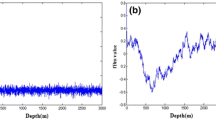Abstract
In this study, a carbonate oil reservoir located in the southeast part of Turkey was characterized by the use of kriging and the fractal geometry. The three-dimensional porosity and permeability distributions were generated by both aforementioned methods by using the wireline porosity logs and core plug permeability measurements taken from six wells of the field. Since classical regression (lognormal or polynomial) and geostatistical techniques (cross variograms) fail to estimate permeability from wireline log-porosity data, the use of artificial neural networks (ANNs) is proposed in this study to generate permeability data at uncored intervals of porosity logs. For both of the methods, kriging and fractal techniques, the validation of the estimated/simulated data with known wellbore data resulted with acceptable agreements, especially for porosity. Also the comparison of both methods at unsampled locations show better agreements for porosity than permeability.
Similar content being viewed by others

References
Aasum, Y., Kelkar, M. G. and Gupta, S. P.: 1991, An application of geostatistics and fractal geometry for reservoir characterisation, SPE Formation Evaluation (March), 11–19.
Arpat, B. G., Gümrah, F. and Yeten, B.: 1998, The neighbourhood approach to prediction of permeability from wire-line logs with limited core plug analysis data using backpropagated artificial neural networks, J. Petrol. Sci. Engng 21.
Deutsch, C. V. and Journel, A. G.: 1992, GSLIB Geostatistical Software Library and User's Guide, Oxford University Press, USA.
Deutsch, C. V. and Hewett, T. A.: 1996, Challenges in reservoir forecasting, Math. Geol. 28(7), 829–842.
Eisenberg, R. A., Harris, P. M., Grant, C. W., Goggin, D. J. and Conner, F. J.: 1994, Modeling reservoir heterogeneity within outer ramp carbonate facies using an outcrop analog, San Andreas formation of the Permian basin, AAPG Bull. 78(9), 1337–1359.
Emanuel, A. S., Alameda, G. K., Behrens, R. A. and Hewett, T. A.: 1989, Reservoir performance prediction methods based on fractal geostatistics, SPE Reservoir Engng (August), 311–318.
Fang, J. H., Chen, H. C. and Visscher, P. B.: 1992, Reservoir characterisation via geostatistical and fractal simulations, Unsollicited paper SPE 25525.
Grant, C., Goggin, D. and Harris, P.: 1994, Outcrop analog for cyclic-shelf reservoirs, San Andreas formation of Permian basin: stratigraphic framework, permeability distribution, geostatistics, and fluid-flow modeling, AAPG Bull. 78, 23–54.
Gümrah, F., Akin, S. and Yeten, B.: 1995, Geostatistical characterisation of a carbonate reservoir located in southeast of Turkey, Eight European Symposium on Improved Oil Recovery, Proceedings, Vol. 1, Vienna, May 15–17.
Hardy, H. H. and Beier, R. A.: 1994, Fractals in Reservoir Engineering, World Scientific Publishing, Singapore.
Hewett, T. A.: 1986, Fractal distributions of reservoir heterogeneity and their influence on fluid transport, 61st Annual Technical Conference and Exhibition of the Society of Petroleum Engineers, New Orleans, Louisiana, SPE Paper 15386, p. 32.
Hewett, T. A. and Behrens, R. A.: 1990, Conditional simulation of reservoir heterogeneity with fractals, SPE Formation Evaluation, pp. 217–225.
Isaaks, E. H. and Srivastava, R. M.: 1989, An Introduction to Applied Geostatistics, Oxford University Press, New York.
Journel, A. G. and Huijbregts, C. J.: 1978, Mining Geostatistics, Academic Press, New York.
Kerans, C., Lucia, F. J. and Senger, R. K.: 1994, Integrated characterisation of carbonate ramp reservoirs using outcrop analogs, AAPG Bull. 78, 181–216.
Pannatier, Y.: 1994, MS-WINDOWS programs for exploratory variography and variogram modeling in 2D, In: V. Capasso, G. Girone and D. Posa (eds), Presented in Statistics of Spatial Processes: Theory and Application Conference, Bari, Italy, September 27–30, 1993, pp. 165–170.
Srivastava, R. M.: 1994, An Overview of Stochastic Methods for Reservoir Characterisation, in Stochastic Modeling and Geostatistics: Principles, Methods, and Case Studies, Am. Assoc. Pet. Geologists, Tulsa, OK.
Ulu, M. and Karahanoglu, N.: 1998, Characterization of the Karababa-C reservoir in the South Karakus Oilfield, southeast Turkey, Marine Petrol. Geol. 15(8).
Yeten, B.: 1997, Applicability of geostatistical and fractal techniques for characterising and deriving reservoir grid-block values for numerical simulation, MSc Thesis, Middle East Technical University, Department of Petroleum and Natural Gas Engineering, Ankara, Turkey.
Author information
Authors and Affiliations
Rights and permissions
About this article
Cite this article
Yeten, B., Gümrah, F. The Use of Fractal Geostatistics and Artificial Neural Networks for Carbonate Reservoir Characterization. Transport in Porous Media 41, 173–195 (2000). https://doi.org/10.1023/A:1006725709303
Issue Date:
DOI: https://doi.org/10.1023/A:1006725709303



